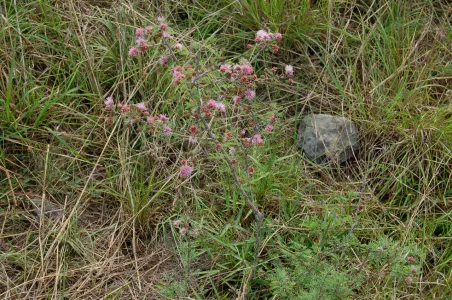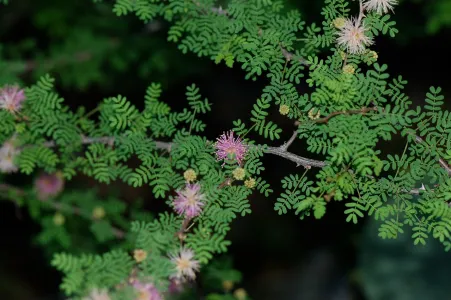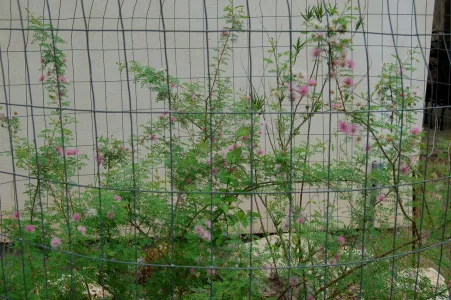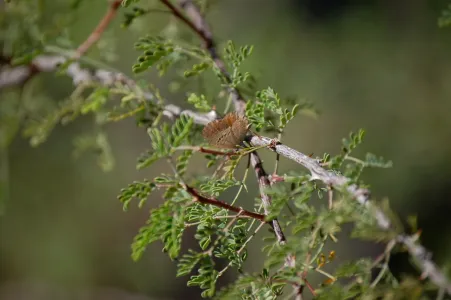By Delmar Cain
It was about 20 inches tall, had tiny leaves, and was growing in the middle of a vacant lot in the subdivision. It had been browsed, probably by deer, and looked stunted. Had it not been for the ball-like pink flowers I would have passed it by with no second thought. But when I took a closer look, I saw that it had small, recurved prickles that reminded me of all the shrubs that mercilessly grabbed my legs, arms and occasionally an ear in South Texas when I had foolishly chased quail through the brush country. The flowers had a lovely fragrance. My curiosity was also pricked.

The answer came as soon as I looked on p. 56 in Marshall Enquist’s great reference book for our area, “Wildflowers of the Texas Hill Country”. It was as he described it “…an erect, tortured-looking shrub 3-6’ tall found on brushy flats and hillsides.” I had just seen my first specimen of pink mimosa or fragrant mimosa (Mimosa borealis), scientifically named by Asa Gray, a professor of natural history at Harvard and the preeminent American botanist of the 19th century.
With good reason the Boerne Chapter of the Native Plant Society of Texas (NPSOT) has selected the fragrant mimosa as the March Plant of the Month for the NICE (natives instead of common exotics) Program.

Pink mimosa grows in a variety of soils including rocky limestone soils, caliche, sandy loams and clay loams. It is both cold and heat tolerant and requires little or no supplemental water after it is established. It can grow in full sun and in part shade, but it will probably produce more blooms in full sun. Its fragrant and eye-catching pink to whitish-pink flowers, blooming normally in the March-July period, are a nectar source for bees and butterflies. It has been listed as highly resistant to browsing by deer. But deer browsed the first plant that I saw and also the two that I planted. The deer in my area may have an iron-jawed goat somewhere in their family tree.
In spite of its prickly nature, so similar to many plants in the brush country, fragrant mimosa is not native to deep South Texas. It is more commonly found north of Bexar County into Kansas and Colorado and west into New Mexico. Asa Gray, who twice traveled west for botanical research after the Civil War, may have collected specimens of the plant in Colorado, which he visited.
The compound leaves of the pink mimosa, a member of the Fabaceae (Pea Family), share a similarity to the leaves of many other members of the family, including mesquite and acacias. Each pink mimosa leaf is composed of a stem, which may branch 3 or 4 times, with as many as 6 pairs of tiny leaflets on each branched stem. The leaves somehow remind me of bonsai pecan leaf.

Fragrant mimosa can serve as a colorful addition to a xeric garden. I would not plant it near a walkway, unless it is walkway that you want to abandon. With its curved prickles, the plant can and will grab you. Planting and care instructions can be found under “Plant of the Month” on the Boerne Chapter website at: http://www.npsot.org/wp/boerne/
At our last Boerne Chapter meeting (which always meets on the first Tuesday of the month) we were fortunate to have a very entertaining and educational presentation by Craig Hensley, Park Interpreter and Naturalist, at the Guadalupe River State Park. His topic for the evening was the natural history of Texas milkweeds, which you probably know are the host plants for the monarch butterfly. He is an enthusiastic educator for all ages; and he finds inspiration in every butterfly and plant, even if he has seen it 500 times before. If you haven’t been to the State Park recently you should put it on your “To Do” list, especially if you can join a walk or a class with Craig.
In January the Boerne chapter enjoyed a presentation by Michael Warriner, an invertebrate biologist, with the Texas Parks and Wildlife Department in Austin. His presentation on bees with an emphasis on bumblebees was thoroughly appreciated.

The topics of both of the speakers were timely given the recent reports of the severe decline in the numbers for monarch butterflies and an attempt to restrict the use of pesticides in the European Union, due to the alarming decline of honey bees. The March 15, 2013 New York Times article on the proposed pesticide ban reported that the United Nations Food and Agriculture Organization says that “bees pollinate 71 of the 100 crops that provide 90 percent of the world’s food.”
An “fiscal cliff” might look like crack in the sidewalk when compared with a “food cliff.” On the positive side it might give all of us employment if we have to pollinate every corn plant and the 70 other food crops by hand. Also an investment in tweezers manufacturers might be timely.
It is encouraging to know that in these austere financial times the state has managed to keep knowledgeable science educators at the Texas Parks and Wildlife Department, like Craig and Michael, who are doing their part to alert us to issues that have long-term significance. In the future how to hand-pollinate our tomato plants might even crowd football as a discussion topic on Coffee Tuesday at the Bear Moon Bakery. Umm! Naw, it’s Texas–probably not.
